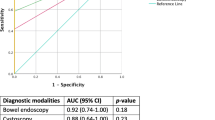Abstract
Background
Radiological imaging is paramount for defining the genitourinary fistulae commonly associated with anorectal malformations prior to definitive surgery. The imaging options are resource-limited in many parts of the world. Nonfluoroscopic pressure colostography after colostomy is a cheap method for the evaluation of anorectal malformations.
Objective
To describe our experience with nonfluoroscopic pressure colostography in the evaluation of anorectal malformations in boys.
Materials and methods
The study included 12 boys with anorectal malformation who had colostomy and nonfluoroscopic pressure-augmented colostography with water-soluble contrast medium between January 2006 and December 2007.
Results
Patient ages ranged from 2 days to 1 year. The types of genitourinary fistula were rectovesical (7.7%) and rectourethral (92.3%). Oblique radiographs were of diagnostic value in all patients. The types of anorectal malformations were high, intermediate and low in 75%, 8.3% and 16.7%, respectively. Short-segment urethral constriction was a common feature of rectourethral fistula (75%, n=9).
Conclusion
Our experience has shown that genitourinary fistulae associated with anorectal malformations can be demonstrated reliably by nonfluoroscopic pressure colostography with two oblique radiographs, providing an option in resource-poor settings where fluoroscopic equipment is scarce.



Similar content being viewed by others
References
Endo M, Hayashi A, Ishihara M et al (1999) Analysis of 1,992 patients with anorectal malformations over the past two decades in Japan. Steering Committee of Japanese Study Group of Anorectal Anomalies. J Pediatr Surg 34:435–441
Spouge D, Baird PA (1986) Imperforate anus in 700,000 consecutive liveborn infants. Am J Med Genet Suppl 2:151–161
Nievelstein RA, Vos A, Valk J (1998) MR imaging of anorectal malformations and associated anomalies. Eur Radiol 8:573–581
McHugh K (1998) The role of radiology in children with anorectal anomalies with particular emphasis on MRI. Eur J Radiol 26:194–199
Beek FJ, Boemers TM, Beek FJ et al (1995) Spine evaluation in children with anorectal malformations. Pediatr Radiol 25:28–32
Peña A (1995) Anorectal malformations. Semin Pediatr Surg 4:35–47
Gupta AK, Guglani B (2005) Imaging of congenital anomalies of the gastrointestinal tract. Indian J Pediatr 72:403–414
Uba AF, Chirdan LB, Ardill W et al (2006) Anorectal anomaly: a review of 82 cases seen at JUTH, Nigeria. Niger Postgrad Med J 13:61–65
Adeyemi SD, de Rocha-Afodu JT (1982) Management of imperforate anus at the Lagos University Teaching Hospital, Nigeria: a review of ten years’ experience. Prog Pediatr Surg 15:187–194
Levitt MA, Peña A (2007) Anorectal malformations. Orphanet J Rare Dis 2:33
Gross GW, Wolfson PJ, Pena A (1991) Augmented-pressure colostogram in imperforate anus with fistula. Pediatr Radiol 21:560–562
Narasimharao KL, Prasad GR, Katariya S et al (1983) Prone cross table lateral view: an alternative to the invertogram in imperforate anus. AJR 140:227–229
Lernau OZ, Jancu J, Nissan S (1978) Demonstration of rectourinary fistulas by pressure gastrografin enema. J Pediatr Surg 13:497–498
Kim IO, Han TI, Kim WS et al (2000) Transperineal ultrasonography in imperforate anus: identification of the internal fistula. J Ultrasound Med 19:211–216
Wang C, Lin J, Lim K (1997) The use of augmented-pressure colostography in imperforate anus. Pediatr Surg Int 12:383–385
Motovic A, Kovalivker M, Man B et al (1979) The value of transperineal injection for the diagnosis of imperforate anus. Ann Surg 190:668–670
Adeniran JO, Abdur-Rahman LO (2005) One-stage correction of intermediate imperforate anus in males. Pediatr Surg Int 21:88–90
Currarino G (1996) The various types of anorectal fistula in male imperforate anus. Pediatr Radiol 26:512–522
Author information
Authors and Affiliations
Corresponding author
Rights and permissions
About this article
Cite this article
Abdulkadir, A.Y., Abdur-Rahman, L.O. & Adesiyun, O.M. Nonfluoroscopic pressure colostography in the evaluation of genitourinary fistula of anorectal malformations: experience in a resource-poor environment. Pediatr Radiol 39, 132–136 (2009). https://doi.org/10.1007/s00247-008-1051-2
Received:
Revised:
Accepted:
Published:
Issue Date:
DOI: https://doi.org/10.1007/s00247-008-1051-2




